Editor’s Note: This week we’re at the 235th AAS Meeting in Honolulu, HI. Along with a team of authors from Astrobites, we will be writing updates on selected events at the meeting and posting each day. Follow along here or at astrobites.com. The usual posting schedule for AAS Nova will resume the week of January 20th.
AAS Prize Presentations and Plenary Lecture: The Role of Feedback in the Evolution of Galaxies (by Ellis Avallone)
This morning started off with Megan Donahue (Michigan State University) awarding AAS prizes. To read more about the prizes and their winners look out for a press release by AAS later this week!
Next, Tim Heckman (Johns Hopkins University) discussed where we’re at in understanding galaxy evolution. Heckman began by introducing this topic through the lens of cosmology. “We’re in the era of precision cosmology.” Because of this, we now have a very good understanding of the evolution of dark matter haloes that surround galaxies as they form and grow. However, we still don’t understand much of the underlying physics that’s involved in the current model of galactic evolution, in which galaxies grow primarily through a series of merger events. This is further complicated by current numerical models, which cannot reach the resolution needed to resolve these physical processes.
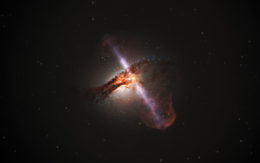
High-speed jets emitted from around supermassive black holes are one type of feedback that can affect galaxy evolution. [ESA/Hubble, L. Calçada (ESO)]
Workshop: Science Communication Through the Lens of Astrobites (by Kate Storey-Fisher and Briley Lewis)

Astrobites authors Briley Lewis and Kate Storey-Fisher led today’s workshop (and had a lot of fun doing so!).
Today we had the chance to bring more Astrobites to AAS through our workshop “Science communication through the lens of Astrobites” led by Astrobites authors Kate Storey-Fisher and Briley Lewis.
So, what makes an Astrobite? We started today’s workshop by discussing two main topics in science communication: language and storytelling. Language choices are particularly important in science writing, since we need to be careful about what jargon we use; deciding which words are appropriate for an article depends entirely on knowing your audience (who they are, why they care, what they already know). Storytelling is also important because it keeps your reader interested, and helps make the information memorable. Basic narrative structures (such as “and, but, therefore”) are great starting places for constructing the story of your science.
After a crash course in these fundamentals of science writing, we set our participants out to write an introduction to their very own Astrobite. Participants came up with compelling intros, steering clear of jargon and incorporating a narrative hook, and then engaged in peer editing and analysis of published Astrobites to improve their drafts. Overall, there was a lot of great discussion on the value of making science accessible, and how to actually accomplish that goal!
Participants were encouraged to write and submit guest posts to Astrobites — if you have a pitch, you can contact us here to submit one! If you’ve been walking around the posters at the exhibit hall, you may have noticed that we also accept undergraduate research submissions, which can be submitted here.
Press Conference: Things That Go Bump in the Night (by Susanna Kohler)
AAS Press Officer Rick Fienberg opened the first press conference of the day with “I think this is the most people I’ve ever fit up on this stage,” introducing the six speakers who were going to tell us about a variety of transient sources.
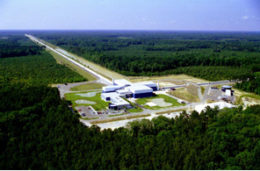
The Livingston LIGO facility, which recently made the first single-detector gravitational-wave event detection. [Caltech/MIT/LIGO Lab]

The location of FRB 180916 is in a galaxy’s spiral arm, marked with a green circle in this image from the Gemini-North telescope. [NSF’s Optical-Infrared Astronomy Research Laboratory/Gemini Observatory/AURA]
Switching gears, Thomas Fauchez (NASA Goddard Space Flight Center) presented on a new technique we can use to detect oxygen in the atmospheres of exoplanets, potentially advancing the search for life beyond the solar system. Oxygen levels similar to Earth’s were previously thought to be too faint to detect on exoplanets, but Fauchez and collaborators conducted simulations showing that an absorption feature at the infrared wavelength of 6.4 µm could give away the presence of oxygen in a planet’s atmosphere — and therefore possibly point to habitability of the world. They show that this feature could be detected in the spectra of nearby planets when observed with the upcoming James Webb Space Telescope. Press release
Last up, Bradley Schaefer (Louisiana State University) opened with his exciting punchline: the binary star V Sagittae, which consists of a white dwarf fed by material from an ordinary star, is inspiraling ever more rapidly and is on course for a collision. Schaefer and collaborators’ best estimates suggest the binary will likely merge soon: in the year 2083, give or take 16 years. As it collides, the system will become as bright as Sirius or even possibly Venus — appearing as a guest star in our sky that will last roughly a month near peak brightness. Mark your calendars! Press release
Helen B. Warner Prize: Not Your Grandparents’ Galaxy: The Milky Way in the Era of Large Surveys (by Mia de los Reyes)
Jo Bovy (University of Toronto) started his plenary talk with a goal: “I want to take you on a journey through the Milky Way,” he said. He listed all the main visible parts of the Milky Way — the disk, the bulge, and the stellar halo — and explained how there are still some big open questions about the MIlky Way’s structure. How did all of these components form and evolve? Perhaps more importantly, how do they all fit together?
We’ve made a lot of strides towards answering these questions in the last decade. “The big difference between now and ten years ago,” said Bovy, are large surveys. Bigger is better when it comes to Milky Way surveys — and we’ve gotten a lot better. For example, we’ve obtained high-resolution spectra of thousands of stars using surveys like SDSS APOGEE, and positions and velocities for 1.7 billion stars with the Gaia satellite.
What have we learned from these large data sets so far? Bovy laid out several of the main results in galactic studies over the past decade, focusing on the different components of the Milky Way. For example, chemical evolution patterns in the Milky Way’s disk indicate that the early disk was extremely uniform, thick, and turbulent — but that it cooled and became thin and chemically stratified (i.e. having more metal-poor stars near the outskirts) at later times. After this thin disk formed, radial mixing processes began to churn the disk, perturbing it and producing transient spiral patterns.
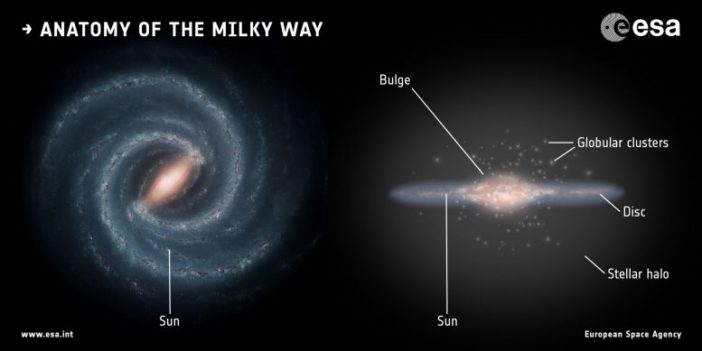
Artist’s impression of the Milky Way, showing its three main visible components: the disk, the halo, and the bulge. [ESA]
Finally, Bovy described the galactic bulge. Although all galaxies have bulges of some kind, only since 1990 or so have we known that the Milky Way has a bar at its center. The bar is chemically similar to the early Milky Way disk and likely formed ~8 Gyr ago from the disk. Bovy showed how the rotation of the bar can be measured using Gaia data, and how the bar has likely just been rotating steadily since its formation.
Bovy then explained how all these results come together to support a single picture of Milky Way evolution — one mostly dominated by internal processes, rather than external processes like major mergers. Bovy ended his plenary talk by pointing out that it’s important for surveys to not only be large but also open and accessible to scientists worldwide. Open data is good for both science and for scientists, so we should all “urge the people in charge to make sure data is fully open!”
Press Conference: TESS Explores Exoplanets & More (by Susanna Kohler)
Paul Hertz, astrophysics division director at NASA Headquarters in Washington, reminds us that just 20 years ago, we didn’t know whether exoplanets were common or rare. Now, we know that nearly every star in the galaxy has exoplanets — and the Transiting Exoplanet Survey Satellite (TESS) has already discovered thousands of these planet candidates in just the first year and a half since its launch. What are some of the latest results coming from this promising mission?The first three presentations of this press conference focused on a major new discovery — the compact multi-planet system TOI 700. Emily Gilbert (University of Chicago) introduced the cool M dwarf located just over 100 light-years away and its newly found planets:
- TOI 700b, an Earth-size, likely rocky planet on a 10-day orbit
- TOI 700c, a larger, likely gaseous planet on an 16-day orbit
… and (drumroll, please) … - TOI 700d, TESS’s first discovery of a roughly Earth-size transiting planet that, with an orbit of 37 days, lies in its host’s habitable zone.
How did we confirm TOI 700d? It seems fitting that, with just a month of observations left before the Spitzer telescope is retired, this venerable spacecraft was the one to detect transits from TOI 700d and confirm TESS’s first Earth-size habitable-zone planet. Joseph Rodriguez (Center for Astrophysics | Harvard & Smithsonian) reported the observations, as well as some ground-based observations further characterizing TOI 700c.
Lastly, Gabrielle Engelmann-Suissa (NASA Goddard Space Flight Center) presented new 3D climate modeling that explores the potential atmosphere of TOI 700d, a tidally locked planet (i.e., the same side of it always faces the star). A number of outcomes are possible — from an ocean-covered world with a dense atmosphere, to a cloudless, all-land version of modern Earth. Eventually, we hope to be able to measure spectra of TOI 700d that we can then compare to the simulated spectra produced by Engelmann-Suissa and collaborators to better understand this planet. Joint press release on TOI 700 Next, Veselin Kostov (NASA Goddard Space Flight Center) presented on TOI 1338, the first circumbinary planet detected by TESS. The planet was discovered in TESS data by Wolf Cukier, a high schooler and summer intern at Nasa Goddard SFC at the time. TOI 1338 lies about 1,300 light-years away, and the two stars of the binary orbit each other once every 15 days. The planet was difficult to spot due to its irregular orbit — between 93 and 95 days — and variable depth and duration; this unusual behavior is due to the orbital motion of its host stars. Press releaseRounding out the session, Angela Kochoska (Villanova University) presented on the binary star Alpha Draconis — the star that, 4,700 years of precession ago when the first pyramids were built in Egypt, had Polaris’s place as the star closest to the north rotational pole of the Earth. Despite being a very well-studied, naked-eye star, Alpha Draconis has only just been discovered to be eclipsing. TESS data revealed the brief eclipses that had been missed by ground-based observations in the past, providing us with a wealth of new information we can use to study this system and analyze its properties. These results demonstrate that TESS is useful not only for exoplanet science, but also for stellar science as well! Press release
Plenary Lecture: The Stewardship of Maunakea’s Legacy from the Perspective of the Hawaiian and Astronomical Communities (by Briley Lewis)
Amy Kalili (‘Ōiwi TV), indigenous language advocate, introduced a perspective on the stewardship of Mauna Kea rooted in the language and culture of Hawaiian communities. Her task today was not to definitively give an answer to the conflict surrounding astronomy on the mauna, but to prompt new thoughts and discussions between the stakeholders involved.
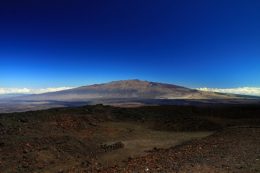
Mauna Kea, as viewed from Mauna Loa Observatory. [Nula666]
Looking forward, her major takeaway is that there is a significant need for greater pilina (relationship building) and ho’oka’a’ike (communication). Pilina is a requisite to build trust, and it takes “time, energy, sincerity, and long-term commitment.” However, it doesn’t mean we have to agree on everything, just that we need to engage with respect. Ho’oka’a’ike engages multiple audiences and voices, especially those that previously may not have had a seat at the table, and prioritizes ho’olohe (listening) over wala’au (talking).
Kalili’s question for those attending this meeting is this: How can we, as astronomers/experts in the field, contribute to pilina, ho’oka’a’ike, and kālailai (analysis/assessment) with regards to the mauna and the Hawaiian community?
She emphasizes that this is not a one time conversation — this discussion needs to be ongoing and dynamic as situations and communities evolve. These principles also apply not only to the current situation surrounding the Thirty Meter Telescope and Mauna Kea, but also more generally to interactions with indigenous communities.
HEAD Bruno Rossi Prize, Kilonovae from Merging Neutron Stars (by Mike Zevin)
How do you turn iron into gold? In the final plenary lecture on Monday at #AAS235, Brian Metzger (Columbia University) and Dan Kasen (University of California, Berkeley) delved into kilonovae, the cosmic explosions responsible for synthesizing the heaviest elements in the universe. Metzger kicked things off by overviewing how heavy elements are created. When two neutron stars collide, they expel neutron-rich ejecta that bombard nuclei at a very high rate, forming large and unstable isotopes that then beta decay back to the valley of stability. This is known as r-process nucleosynthesis (see a visualization of this process here). This radioactive decay powers the kilonova explosion. GW170817, the binary neutron star merger detected by LIGO/Virgo and telescopes across the electromagnetic spectrum, beautifully exhibited this phenomena and produced thousands of Earth masses of r-process material in its cataclysmic collision.
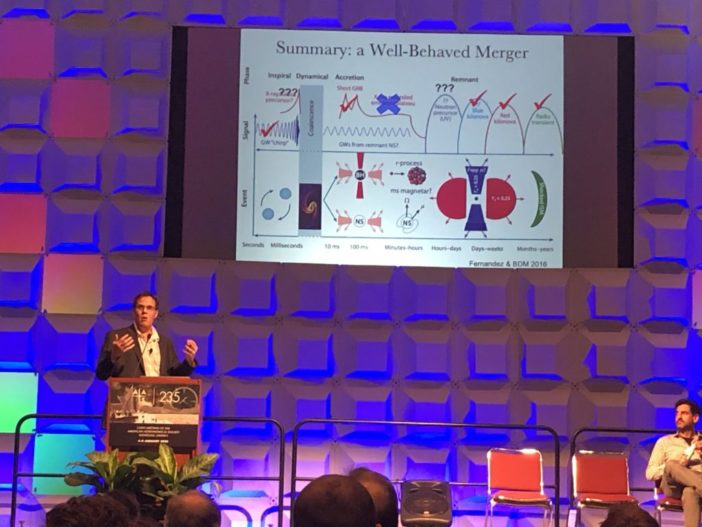
Brian Metzger, a co-awardee of the HEAD Bruno Rossi Prize, describing the steps of a “well-behaved” neutron-star merger and kilonova.
Metzger pointed out that the emission from the kilonova provided important insights into the remnant that formed following the neutron star merger. Did the merger product immediately collapse into a black hole, or did it remain stable as a neutron star for a period of time? Metzger argued that we can rule out a prompt collapse for GW170817 because this scenario would not provide the necessary amount of ejecta that was observed. He also showed how we can rule out a long-lived neutron star, since this would lead to bluer emission than was observed. This points to the merger product of GW170817 likely proceeding through a “hypermassive” neutron star phase, supporting itself for a few hundred milliseconds before collapsing into a black hole. Interestingly, this tells us a great deal about the “equation of state” of neutron stars, which describes the pressure and density of neutron star matter in nature.
Kasen then took over, continuing the story of GW170817 and our understanding of kilonovae. Though Kasen “thought it would be 5 to 10 years before we were confronted with data”, the universe had other plans and provided a gold-plated kilonova on our doorstep only a short while after the Advanced LIGO/Virgo network began acquiring data. After recognizing the long list of authors that contributed to the GW170817 multi-messenger astronomy paper, Kasen noted that understanding kilonovae truly requires a multi-physics description, ranging from dynamics and mass ejection to neutrinos and nucleosynthesis to atomic physics to radioactive heating to radiative transport. Kilonovae provide a complex astrophysical environment and a heavy element factory; whereas about 1 billionth of our solar system is made of r-process material, kilonovae are the size of a solar system and are made up almost entirely of heavy r-process elements. Despite their complexity, theoretical predictions of kilonova light curves, color evolution, spectra, and temperature evolution all matched extremely well with the observations of GW170817. But despite the fact that GW170817 fit well with theoretical predictions, Kasen is confident that surprises await, and that we should have faith that nature is bound to provide something that will have astronomers scratching their heads.
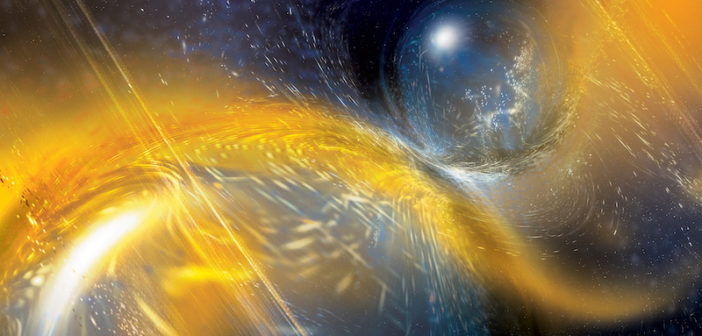
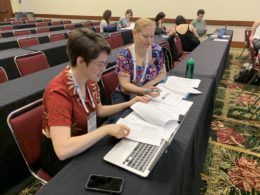
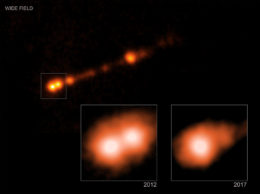
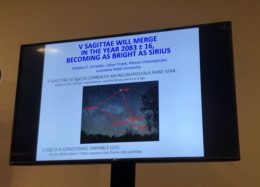


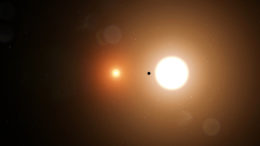
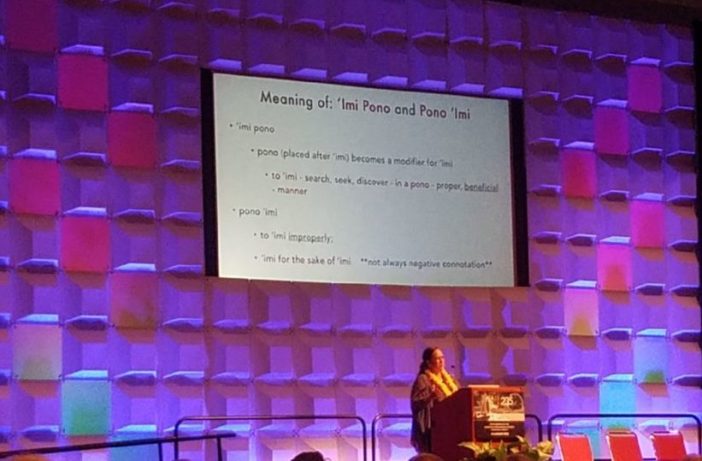
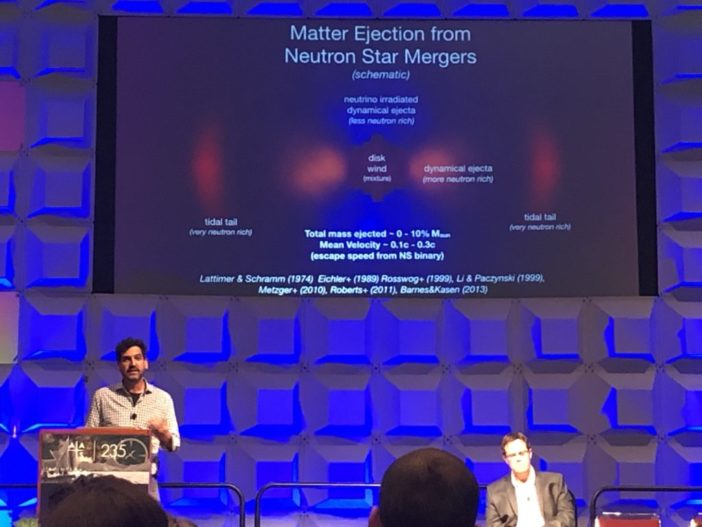
1 Comment
Pingback: Erkenntnisse von der 235. Tagung der AAS | Skyweek Zwei Punkt Null